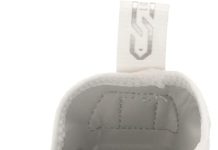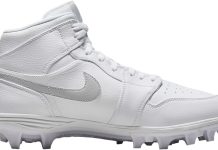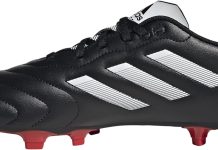Once we’re done with our trusty pair of cleats, it’s natural to wonder what our options are. Can we resell them and allow someone else to chase their dreams on the field? Or perhaps we can donate them to a budding athlete in need?
In this article, we’ll explore what can happen to our cleats once they’ve taken their final kick – because giving our beloved footwear a second life is practical and a chance to spread the joy of playing sports.
Factors to Consider
Review contents
Condition of the Cleats
When deciding whether to resell or donate your cleats, the condition of the cleats plays a crucial role. If your cleats are in excellent condition, with minimal signs of wear and tear, they are more likely to be sought after by potential buyers or recipients. On the other hand, if your cleats are heavily worn, torn, or damaged, it may be challenging to find someone willing to buy or use them.
Brand and Model
The brand and model of your cleats can significantly influence their resale or donation potential. Cleats from well-known brands that are popular among athletes are generally more in demand for resale and donation. These brands often have a reputation for durability and performance, making buyers and recipients more willing to invest in them. Similarly, specific models may have unique features or characteristics that make them highly sought after, increasing their value in the resale market and desirability for donation.
Market Demand
Understanding the current market demand is essential in determining whether to resell or donate your cleats. Researching the demand for similar cleats on online marketplaces, classified ads, or sports forums can give you an idea of how easy or difficult it may be to sell them. If the market demand is high, reselling your cleats and potentially earning some money may be more advantageous. However, if the demand is low, donating the cleats to someone in need may be a more meaningful and beneficial option.
Reselling Cleats
Choosing the Right Platform
When reselling your cleats, choosing the right platform to reach potential buyers is vital. Online platforms like websites and apps dedicated to sports equipment resale, like eBay or SidelineSwap, can provide a broad reach and attract interested buyers. Social media platforms and local classified ads can also target a specific audience, such as local athletes or sports enthusiasts.
Proper Listing Preparation
Proper listing preparation is essential to maximize your chances of successfully selling your cleats. Take high-quality photographs of the cleats from multiple angles, showcasing their condition and any unique features they may have. Write a detailed and accurate description highlighting essential aspects such as brand, model, size, and any notable wear or damage. Providing as much information as possible will help potential buyers make an informed decision.
Setting the Right Price
Pricing your cleats appropriately is crucial for a successful resale. Research the current market value of similar cleats in similar conditions to understand a fair asking price. Remember the brand, model, and any unique features that may add value. Consider factors such as the age of the cleats, the market demand, and any recent updates or releases of newer models that may affect the desirability and value of your cleats. Setting a reasonable price will attract potential buyers while ensuring you receive a fair return.
Shipping and Packaging
Once you have found a buyer for your cleats, proper shipping and packaging are necessary to ensure they arrive in good condition. Clean the cleats thoroughly, removing any dirt, mud, or odors. Stuff the cleats with tissue paper or socks to help maintain their shape during shipping. Securely package the cleats in a suitable box, ensuring enough padding and protection to prevent damage. Consider using a shipping service that offers tracking and insurance to provide you and the buyer peace of mind.
Donating Cleats
Researching Donation Organizations
Research reputable donation organizations are crucial if you decide to donate your cleats. Look for organizations that expressly accept sports equipment donations, as they will better understand the value and impact of cleats. Ensure that the organizations align with your values and have a proven track record of efficiently distributing donations to needy individuals or communities.
Ensuring Cleats Meet Donation Requirements
Donation organizations may have specific requirements for the condition and type of cleats they accept. Some organizations may only accept lightly used or almost new cleats, while others may prioritize any cleats in decent condition. Confirm the organization’s guidelines regarding the cleats’ size, functionality, age, and sanitation requirements. Ensuring your cleats meet these requirements will increase the likelihood of them being accepted and put to good use.
Shipping and Packaging
Donating cleats, shipping, and packaging play a significant role in safely reaching the intended recipient. Follow the same steps for cleaning and packaging as mentioned in the reselling section to prepare the cleats for shipping. Confirm with the donation organization whether they cover the shipping cost or if you are responsible for it. Additionally, inquire about any specific instructions or documentation needed for shipping, such as a donation form or labeling.
Tax Deductible Benefits
One of the advantages of donating your cleats is the potential for tax deductions. Charitable donations, including sports equipment donations, can often be claimed as deductions on your tax return. However, consulting with a tax professional or referring to the applicable tax laws in your jurisdiction is essential to understand the specific requirements and limitations for deducting charitable donations. Keeping records of the donation, including receipts and any documentation provided by the donation organization, will be necessary for tax purposes.
Alternatives to Reselling or Donating
Trading with Friends or Teammates
If you have friends or teammates who need cleats or have cleats they no longer use, trading can be a convenient and mutually beneficial alternative. This eliminates the need for monetary transactions and allows you to pass on your cleats to someone you know and trust. Trading can also foster a sense of camaraderie and strengthen relationships within your sports community.
Upcycling Cleats
Upcycling your cleats can be a creative and sustainable option if they are in poor condition and unsuitable for resale, donation, or trading. Repurposing cleats into unique decorative items, such as planters or wall displays, can give them a new lease on life and add a touch of personality to your living space. Alternatively, you can explore local recycling programs specializing in repurposing or recycling sports equipment to ensure they are disposed of responsibly.
Conclusion
When deciding what to do with your cleats after you’re done with them, there are several factors to consider. Assessing the condition of the cleats, considering the brand and model, and understanding the market demand can help determine whether reselling or donating is the best option.
If reselling, choose the right platform, prepare the listing properly, set the right price, and ensure secure shipping and packaging. If donating, research donation organizations, ensure the cleats meet requirements, handle shipping and packaging properly, and be aware of potential tax benefits.
Trading with friends or upcycling the cleats are also viable alternatives. By making an informed decision, you can extend the life of your cleats and positively impact someone else’s athletic journey.





































